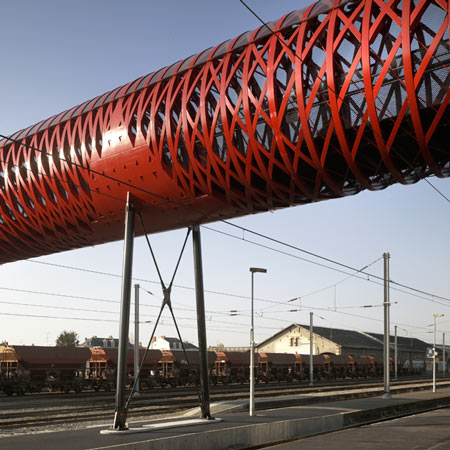A pedestrian bridge designed by American New York-based architect Bernard Tschumi and French firm Hugh Dutton Associés has opened in La Roche-sur-Yon in France.
The tubular lattice bridge connects the old centre of Atlantic coast town with newer districts across the TGV railway tracks.
Photos are copyright © Christian Richters/VIEW
Here's some info from the architectural team:
INAUGURATION OF PEDESTRIAN BRIDGE FOR LA ROCHE-SUR-YON, DESIGNED BY BERNARD TSCHUMI AND HUGH DUTTON
LA ROCHE-SUR-YON, FRANCE March 9, 2010: A public ceremony on February 6th inaugurated a footbridge in La Roche-sur-Yon, France, designed by Bernard Tschumi Architects and Hugh Dutton Associates. The bridge's cylindrical structure aims to express the loads and stresses on the bridge while creating an original and contemporary statement for the town, located near resort communities of the western coast.
The extension of the TGV train to La Roche-sur-Yon and nearby towns bordering the Atlantic marks not only an important moment for the modernization of the European and French train network, but also an occasion to initiate civic improvements. Linking the historic city founded by Napoleon (“the Pentagon”) with new neighborhoods, this pedestrian bridge crosses above high-speed railway tracks, providing an important urban connection for the town.
Conceived through joint collaboration between the fields of architecture and engineering, the bridge was designed by Bernard Tschumi and Hugh Dutton, with their respective teams in Paris and New York. The teams developed the design for La Roche-sur-Yon as both a utilitarian vector of movement and a symbol of contemporary urban relationships. The intention of the designers was to demonstrate an integration of an original structural system with an architectural concept developed from urban scale research of neighborhood identity and carried through the expression of the minutest details.
It has been said that there is no architecture without movement. A pedestrian bridge is not just a static object, but represents a dynamic vector in both its usage and urban perception. The designers have sought to express this dynamic characteristic, as much through the structural system as through finishing materials (interlaced polycarbonate surfaces protect passengers from weather conditions, while lighting follows the rhythm of the structure). Even the bright red-orange color was chosen to emphasize the urban significance of the bridge as a pedestrian vector.
Structure
The new bridge replaces an existing structure, a standard railway design that can be found all over France, contemporary with and inspired by the work of Eiffel, using lateral beams composed of a diagonal mesh of small plate strips that are riveted together. The design of the new bridge uses the same language of a diagonal mesh, but in a tubular from, to create a complete cylindrical volume through which the users pass. Footbridges over railways require lateral protection for safety of both the users and the trains below. The complete volume provides a single structural solution that possesses the necessary inertia to span between the available support points as well as provide support for the required protective screens and a canopy cover.
Robert le Ricolais, a distinguished thinker and innovator in architectural and engineering design was born in La Roche-sur-Yon, worked in France before World War 2 and then moved to the University of Pennsylvania. He is known for his research work in the development of spatial three dimensional structures, studying structural concepts such as weightlessness and the infinite span. His work extended beyond architecture and engineering to painting and poetry. The bridge design is an homage to him.
The triangulated mesh of the main structural tube is articulated to distinguish between the tensile and compression forces by using simple tie rods for the tensile members. The ties have no compressive capacity and express therefore the tensile zones. The compressive members are in ‘T’ or ‘H’ sections corresponding to the magnitude of forces in them. The section sizes of the members vary as a function of the loading to optimize the steel mass and further express the forces in the system. Mid-span, the lower chords are tensile, while the upper members are compressed. The inverse is true at the support points, where the bending moments are inverted. The shear forces in tubular truss are generally greater at the support points and tending more and more vertical the closer one approaches the supports. The pattern of triangulation of the truss follows this change in direction of forces. The general objective is to find a harmonious geometric composition that expresses the natural passage of forces.
Team
The complexity of the project required the expertise of in international team. Team leaders included Bernard Tschumi and Hugh Dutton, associated architect Veronique Descharrières within BTuA, and Pierluigi Bucci and Pierre Chassagne, engineers at HDA. Jean-Marie Garnier of the SNCF managed the project for the client and coordinated implementation.
LA ROCHE-SUR-YON FOOTBRIDGE
La Roche-sur-Yon, France
ARCHITECTS:
Bernard Tschumi and Hugh Dutton
ARCHITECTURAL DESIGN:
Bernard Tschumi Architects (BTA), joint representative, including general design and preliminary urban studies.
ARCHITECTURAL AND STRUCTURAL DESIGN:
Hugh Dutton Associates (HDA)
BTA DESIGN TEAM:
Schematic Design, Design Development: Francoise Akinosho, Ben Edelberg, Kim Starr. Construction Documents / Site Supervision : Véronique Descharrières, Vincent Prunier, Rémy Cointet, Alice Dufourmontelle
HDA DESIGN TEAM:
Pierluigi Bucci, Pierre Chassagne, Francesco Cingolani, Maria Angela Corsi, Pietro Demontis, Gaëtan Kolher, Cathy Shortle, Romain Stieltjes, Carla Zaccheddu
CLIENT:
City of La Roche-sur-Yon
PROJECT TEAM:
SNCF - Engineering Department, Jean-Marie Garnier
CONTRACTOR:
Renaudat Centre Constructions
PHOTOGRAPHY:
© Christian Richters
TECHNICAL DATA:
67 meters (35+32 spans)
201 square meters of concrete deck
160 tons of total weight, of which 130 tons of steel ie 1,9 tons per linear meter
76 circular diaphragms, 2100 compressive diagonals, 600 tensile rods
4300 meters of profiles, about 10 km of welding, 1800 conical nodes

